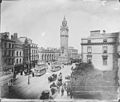Belfast Street Tramways
4 ft 8+1⁄2 in) and 5 ft 3 in (1,600 mm)
The Belfast Street Tramways operated horse-drawn tramway services in Belfast from 1872 to 1905.[1] Its lines later formed a major part of the Belfast Corporation Tramways.
History
The initial tramway services were constructed by the Belfast Tramways Company
On 10 August 1872 they were taken over by the Belfast Street Tramways Company. The initial track gauge was 5 ft 3 in (1,600 mm).[2] The depots were on Sandy Row, Lisburn Road, Mount Pottinger, Knock, Antrim Road and Falls Road.
Steam tram experiment
On 30 June 1877 a Henry Hughes and Company steam tram engine "The Pioneer" was tried on the Belfast system. Despite the trial proving successful with no smoke or noise emitted and no horses being frightened, official permission to operate steam services was not forthcoming.
On 29 November 1877 the company promoted the bill to revise the track gauge to 1,435 mm (4 ft 8+1⁄2 in). The bill was passed in 1878 but the clauses to allow steam working were removed because of objections from John Freeman-Mitford, 1st Earl of Redesdale.
Sydenham District, Belfast Tramway
This independent company built a line from Old Holywood Road, Belmont to connect with Belfast Street Tramways on the Newtownards Road. The company leased tramcars and staff from the Belfast Street Tramways Company.
In 1902 the company was purchased by the Belfast Street Tramways Company.
Belfast and Ligoniel Tramway
This independent company built a line from Ligoniel to connect with the Belfast Street Tramways at the Brookfield Street, Crumlin Road intersection. Services started on 24 April 1893.
In 1902 the company was purchased by the Belfast Street Tramways Company.
Belfast and County Down Railway tramway
The Belfast and County Down Railway constructed this 111 yards (101 m) line to connect Belfast Queen's Quay railway station to the Belfast Street Tramways line near Queen's Bridge. The tramcars on this line were operated by the Belfast Street Tramways Company.
This line was purchased by Belfast Corporation in 1902.
Closure
The company was purchased by Belfast Corporation on 1 January 1905, comprising 171 tramcars, 2 horse buses, and 4 water trams.
The corporation undertook a programme of modernisation and electrification, and services continued as Belfast Corporation Tramways.
Tramcar 118 survived and has been restored and is now on view at the Ulster Folk and Transport Museum, Cultra.
Gallery
-
 A tram in Bedford Street near the Ulster Hall circa 1890.
A tram in Bedford Street near the Ulster Hall circa 1890. -
 The Albert Clock in 1901 with horse trams.
The Albert Clock in 1901 with horse trams. -
 The Albert Clock with electric trams edited onto the previous picture with horse trams.
The Albert Clock with electric trams edited onto the previous picture with horse trams. -
 A steam tram on the Antrim Road.
A steam tram on the Antrim Road.
References
- v
- t
- e
- Aberdare
- Barmouth Junction & Arthog
- Cardiff Corporation
- Cardiff Company
- Cardiff District and Penarth Harbour
- Fairbourne
- Glyn Valley
- Great Orme
- Harlech
- Llandudno & Colwyn Bay
- Llanelly
- Llanelly and District Electric
- Merthyr Tydfil
- Neath & District
- Neath Corporation
- Newport Company
- Newport Corporation
- Oystermouth
- Pontypridd and Rhondda Valley
- Pontypridd Urban District
- Pwllheli & Llanbedrog
- Pwllheli Corporation
- Rhondda
- Swansea & Mumbles
- Swansea Improvements
- Swansea Constitution Hill Incline
- Wrexham District
- Wrexham & District Electric
- Aberdeen District
- Aberdeen Corporation
- Aberdeen Suburban
- Airdrie & Coatbridge
- Ayr
- Carstairs House
- Cruden Bay Hotel
- Dumbarton
- Dundee & District
- Dundee Corporation
- Dundee, Broughty Ferry & District
- Dunfermline
- Edinburgh Street
- Edinburgh & District
- Edinburgh Northern
- Edinburgh Corporation
- Falkirk
- Glasgow Company
- Glasgow Corporation
- Glasgow & Ibrox
- Greenock & Port Glasgow
- Inchture
- Kilmarnock
- Kirkcaldy
- Lanarkshire
- Leith
- Musselburgh
- Paisley
- Paisley District
- Perth & District
- Perth Corporation
- Rothesay & Ettrick Bay
- Stirling & Bridge of Allan
- Vale of Clyde
- Wemyss
- Scottish Tramway and Transport Society
and suppliers
- British Thompson-Houston
- Brush Electrical Engineering Company
- Dick, Kerr & Co.
- Electric Railway and Tramway Carriage Works
- English Electric
- Thomas Green & Son
- Hurst Nelson
- Kitson and Company
- Lancaster Carriage and Wagon Works
- Maley & Taunton
- Manlove, Alliott & Co. Ltd.
- Merryweather & Sons
- Midland Railway Carriage and Wagon Company
- G.F. Milnes & Co.
- Milnes Voss
- Starbuck Car and Wagon Company
- United Electric Car Company
- William Wilkinson
companies
- Balfour Beatty
- Birmingham and Midland Tramways Joint Committee
- British Electric Traction
- British Thomson-Houston
- National Electric Construction Company
- New General Traction Company
- Imperial Tramways Company
- Patent Cable Tramways Corporation
- Provincial Tramways Company














